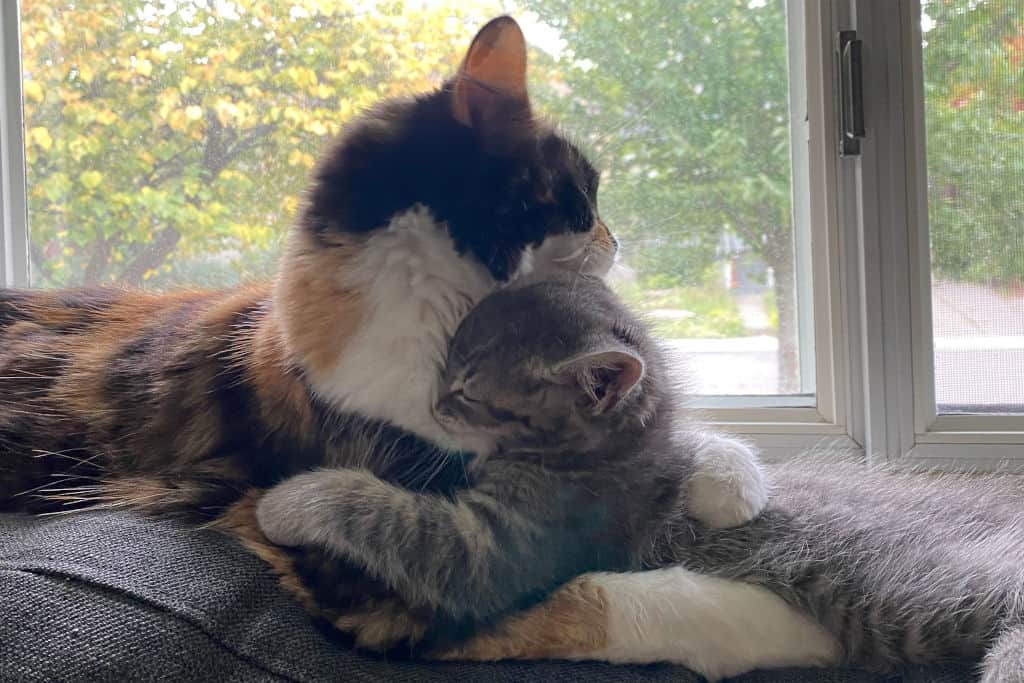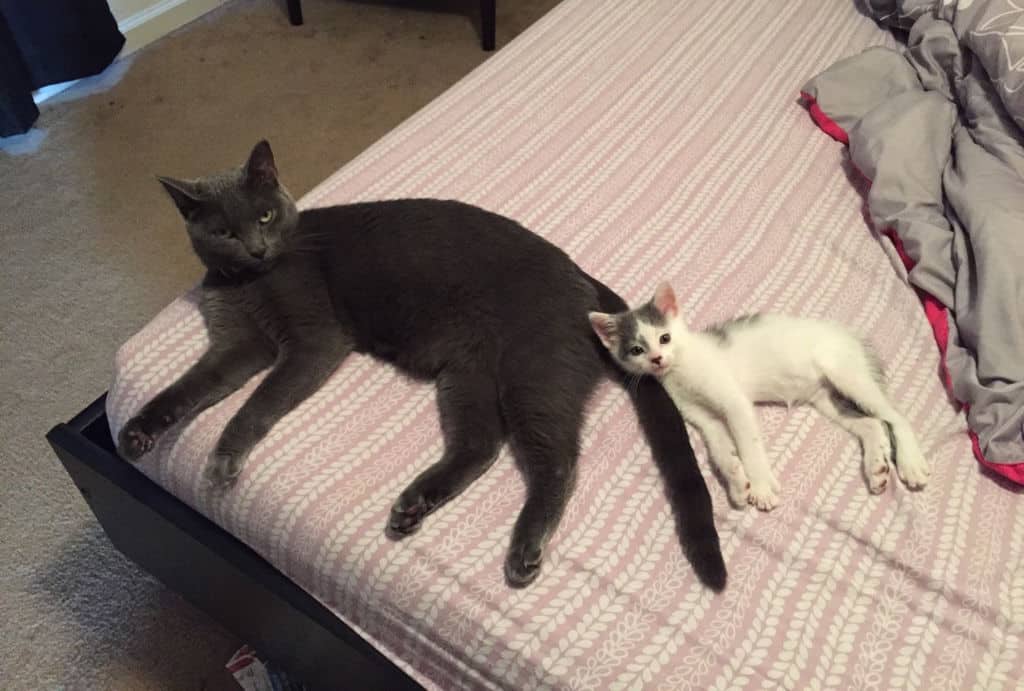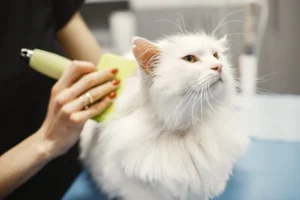Disclosure: We may earn a commission from helpful, relevant links in our content. No cost to you. See our privacy policy.
Disclosure: We may earn a commission from helpful, relevant links in our content. No cost to you. See our privacy policy.
Most cats do not get mad or hold grudges against people. What’s going on is that the cat is usually on high alert because a strange cat has moved into his domain. He’s not responding to your affectionate gestures because your cat may be too preoccupied with the new kitten.
You should take a step back and separate the cats for a while. There is a standard introduction procedure that you should follow. (skip to introduction tips)

Do Gets Get Mad When Getting a New Kitten?
Generally, your cat isn’t upset with you, but it can take time for two cats to become acquainted. While they acclimate, they will behave differently than you are accustomed to. This behavior is natural and has little to do with you and more with the new cat in the house.
For cats, the cause could be as simple as a shift in routine. A cat is a creature of habit. Therefore, disrupting their daily habits might cause discomfort, whether you have a cat or a dog. If a cat perceives that the territory is threatened, they may show behavioral changes.
Remember, if your cat seems to give you the cold shoulder, it’s not out of malice. They’re not thinking, ‘my cat is mad at me for bringing home a kitten.’ Instead, they’re processing the changes and figuring out how the new addition fits into their world.
In his book ‘The Trainable Cat‘, the bestselling anthrozoologist John Bradshaw shares that it’s easier to introduce a kitten to an adult cat than to introduce two adults to each other, but the latter may be doable if the two adult cats are related.
Adding a friend is beneficial sometimes, but kittens don’t usually sit well with older cats. You want complementary personalities, such as a submissive and a dominant, a neutral and a dominant, and so on.
Even if you bring a companion animal home with the greatest of intentions, the manner of introduction, if done incorrectly, can cause tremendous stress and territorial difficulties.
When a new kitty is introduced, cats who did not grow up with other cats may become possessive, aggressive, or afraid. Assure that your resident cat controls the rest of the house. After all, it was her home first and foremost, and she will fiercely protect it.
What Are the Signs Your Cat Doesn’t Like a New Kitten?
When I brought a second cat into the house, the first one hissed, growled, and generally expressed her displeasure at the presence of another cat. It’s a natural instinct for cats to defend their territory and establish status.
The hissing and snarling will last many days to several weeks. Separate them and introduce the other cat’s scent through a sock, blanket, or other material to make it easy on them.
When we weren’t around, we kept them in different rooms. We eased them in by allowing them to scent each other from a safe distance. They stopped hissing at each other after about a week, and they’re still best friends over a year later.
While it might be tempting to interpret hissing as pure aggression, it’s also a cat’s way of setting boundaries. Think of it as your cat saying, ‘Hey, I need space!’ rather than expressing pure hostility.”
Take things slowly. Watch the new and elderly cats, and they’ll become used to each other.
The cats will need time to acclimatize, so be patient and avoid attempting to force a friendship between them. They may eventually get along or even become best friends after a while.
Signs Your Cat Is Accepting the New Kitten
“Is my older cat finally warming up to the newcomer?” you might wonder. Well, there are some specific signs to watch for that hint your resident feline is beginning to accept the new kitten.
- Grooming Sessions. If you catch your older cat grooming the new kitten, this is a fantastic sign! Cats groom those they’re close to, a behavior often rooted in their kittenhood when their mothers used to lick them.
- Sleeping Together. Finding both cats curled up together during nap time means your older cat is becoming comfortable with the new kitten’s presence.
- Shared Playtimes. If you observe them playing – chasing each other, playfully wrestling – it indicates they’re building a friendly rapport.
- No More Hissing or Growling. A decrease or complete halt in aggressive vocalizations when they’re in each other’s presence is a significant sign of acceptance.
- Eating Together Peacefully. Meal times can be territorial moments for cats. If both cats can eat side by side without any hissing, growling, or posturing, it’s a clear indication of mutual respect and acceptance.
- Mutual Scent Marking. Cats have scent glands on their cheeks. If you see them rubbing their faces against each other, they’re mixing their scents. It means they’re accepting each other as part of their “family” or social group.
The key is to look for positive interactions or even just peaceful coexistence. And always celebrate the little victories! If you spot any of these signs, give yourself a pat on the back, because you’re successfully fostering a harmonious feline household.
How Long Does It Take a Cat to Accept a New Kitten?
It could take up to a month for them to feel at ease with each other, but they will.
It may take some time for the new cat to bond with you and come out of hiding spots, depending on whether he’s a kitten or an adult, his level of socialization, and the type of environment he recently left. To win him over, use treats, food, and engaging playing. (From Pam Johnson-Bennetts’s book, Think Like a Cat).

When we fed them, the resident cat spent about two weeks hissing on the opposite side of the door or baby gate. The new cat was then constantly hunted throughout the first few actual introductions. It took about four weeks for us to be able to leave them alone together.
You can move on to site switching or feeding through a cracked door/baby gate if they aren’t making hostile vocalizations at each other through the door. Because each cat is unique, you should go at its own pace.
How to Make Your Cat Get Along With a New Kitten?
Always try to introduce the cats gradually and appropriately. Allowing them to sort it out on their own is a recipe for catastrophe and perpetuates the myth that cats are lonely creatures best left alone. Sure, it might work occasionally, but it’s a significant risk.
You activate the territorial panic switch in your existing cat when it fails. This implies the two cats will go to fight using their natural cat senses. You’ll avoid a long-term lack of trust between the cats this way, but they’ll also take their time which can make them better friends.
First, ensure that you have transitioned your current cat to a meal-feeding pattern rather than free feeding her.
Then, cat-proof the house. Preventive precautions for a single cat may include child locks on cabinets, stove covers, etc. Of course, this should be done regardless, but shutting off hard-to-reach regions is a higher priority for integration.
Make sure that when the cats come into contact, they can do it safely within each of the cats’ territories. Remove all dead ends in the house so that each cat may safely exit if necessary.
Choose a location for the new cat’s base camp. This could be the main bedroom, a spare bedroom, an office, or even the bathroom if there are no other options. Then begin to introduce the new cat.
A kitten who has had pleasant interactions with several cats in their early life is likelier to see other cats positively later in life. Proper introductions are a necessary step, whether it’s a kitten or a puppy.
Now you can begin introducing the two cats. The first phase of introductions will involve scent. You’ll need a pair of socks for this. Place one sock on your hand and massage the new cat’s aroma over the sock. Rub around his face, paying particular attention to the sides of his mouth. Leave the scented sock in the domain of your resident cat.
Use the second sock to groom your regular cat, then place it in the newcomer’s room. This allows the cats to become acquainted with each other’s odors in a safe and non-threatening manner. You can repeat this process with a few socks.
If your resident cat does not show aggressiveness while sniffing the sock, reward her with a treat. Click and treat when the cat approaches the sock if you’re using clicker training, and do it before she has a chance to hiss or growl. Ignore your cat if she reacts unfavorably to the perfumed sock. If you shoo her away or chastise her, she will not learn to associate positively with the new kitty.
When the scented sock exchange goes well, you can include more of the newcomer’s aroma in the surroundings. Place your resident cat in another room and allow the newcomer to investigate. He’ll distribute his scent as he wanders and rubs against objects as he explores beyond his sanctuary chamber.

If everything is going well, you can now slightly open the sanctuary room door and feed the cats nearby but at a distance. Keep the sessions brief and to the point. It’s preferable to finish the session before the food runs out. Eventually, the cats will start to accept each other.
Remember, hissing at the scent of a new kitten isn’t necessarily a sign of eternal dislike. Cats use hissing as a form of communication, and it’s their way of expressing uncertainty, discomfort, or a simple ‘I’m not sure about this yet.'”
Getting Two Kittens Is Better for Your Current Cat
Given how hyper-energetic kittens are, getting a new kitten is usually a bad energy fit for your adult cat. In addition, when they reach the adolescent stage at about six months, they apply what they’ve learned by pressing buttons to see what kind of response they’ll get.
This typically does not entertain older cats. A kitten will likely drive your older cat insane rather than bring out her mother’s instinct. Two kittens will be a better scenario if your cat doesn’t want to go through that.
Two kittens will at least entertain each other, providing them a massive advantage in social development. This situation will be less stressful for the senior cat. Having a feline friend is better for them and better for you, and, contrary to popular belief, they will be less work.
Will New Kitten Cause Old Cat to Run Away?
Introducing a new cat into the family can be stressful, especially for an existing cat. If the established cat becomes overly worried, it may hide and, in some cases, flee. Most of the time, this doesn’t happen, and they may purposely hide from you owing to their hurt feelings.
That is why, before getting a new cat, you should consider when and how you will bring it into your home. Choosing a moment when everything is calm, and you have plenty of time to spend with the cats is critical.
FAQs
Is it okay if my cat hisses at the new kitten?
Your cat may hiss at the new kitten, which is normal. However, it would help if you acted quickly so the hissing could be interrupted. For example, when introducing the cats, you can use clicker training to click and treat before the cat has a chance to hiss at the kitten.
Will getting a second cat affect my current cat’s personality?
Before adding another cat, you must first get to know your current one. Your cats need to complement each other. In the case of kittens, if you don’t do gradual introductions and force them to like each other, your resident may permanently change their behavior towards you.
Can a cat reject a new kitten completely?
With proper introductions, your resident cat will accept the new kitten entirely, and they may become great friends. However, sometimes a cat will only partially accept a new kitten. The two cats may coexist, keeping the other cat in the house at bay.
Alex, a passionate animal lover, has experience in training and understanding animal behavior. As a proud pet parent to two dogs and three cats, he founded AnimalReport.net to share insights from animal experts and expand his knowledge of the animal kingdom.




